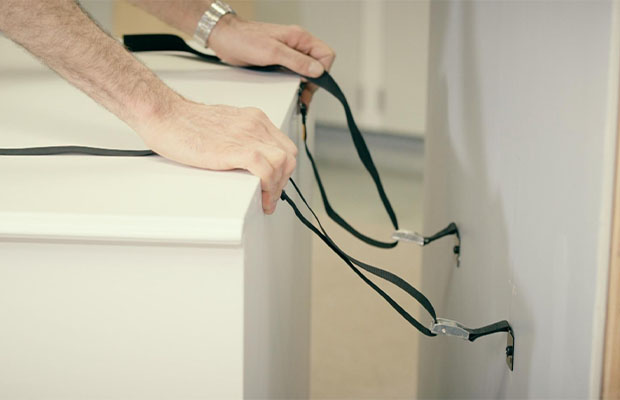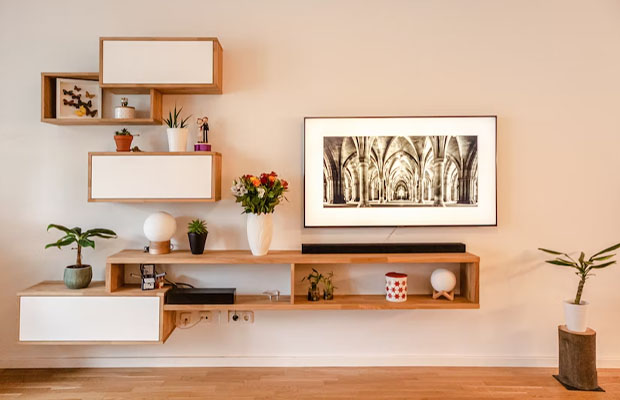Dressers and other large furniture can be secured in a matter of minutes, potentially saving a life.
Finding a secure method to fasten furniture to a wall without using screws can be difficult. How to secure furniture to wall?
The use of adhesives, tiny hooks, or pins that attach to the wall or stud can help secure furniture to the wall using anti-tip kits. You can also try your luck mounting brackets or L-hooks with a strong construction adhesive.
To prevent holes or other damage to the wall while maintaining the position of a sofa, bookshelf, or dresser, we looked into a number of techniques and tools. Keep reading!
Table of Contents
How To Secure Furniture To Wall?
1. Use L-brackets For Fixing Wardrobes Or Chests Of Drawers To Walls
Often, furniture will come with brackets included, but if not, you can purchase an L-shaped corner bracket from any ironmongery or DIY store.
Other names for them include L-brackets, corner brackets, and corner braces. Some will already have the screws included; if not, ask for assistance when purchasing it to ensure that you get the proper size screws to match your bracket.
2. Use The Right Tools For The Job
An electric drill, a 5.5mm masonry drill bit, a Phillips screw head, screws, a Phillips screwdriver, a pencil (behind the ear is optional), a step-ladder, a spirit level, and Rawlplugs (the red ones), if it’s going to be attached to a brick wall, are required for this project.
You must first determine whether the wall you are fixing it to is a brick wall—typically one of your home’s party walls—or if it is a stud wall—an internal wall that makes a hollow sound when you knock on it.
You’ll also require a drill. For most of my work, I use a Dewalt cordless drill (Amazon). Their DIY models are also excellent, but my version will cost you a few pounds. A great Dewalt cordless drill for all your home needs is available for less than 100 pounds.3. Make sure your wardrobe is level before fixing to a brick wall
Even if it’s a small wardrobe, I like to use two brackets when mounting furniture to a wall for extra security—one on either end. Put your wardrobe in place by pushing it back against your skirting boards as far as it will go.
You can support the front legs of your wardrobe with a small piece of plywood under each leg or even some folded cardboard if it still tilts forward, for instance, because a carpet gripper-rod at the room’s edge raises the back legs a little bit. The top of the wardrobe should be level, so use your spirit level to check. Reach the top of the wardrobe with your stepladder to see that the back of the wardrobe should be set back from the wall by the same amount as the skirting board.
As you position your bracket, mark the hole’s outline on the wall with your pencil. To keep track of the center while drilling the hole, draw a cross through the circle after removing the bracket. Set the high-speed hammer setting on your drill. Hold the vacuum nozzle’s tip as close to the hole as you can while drilling. To complete this task, you might need an extra set of hands, but it’s very helpful to vacuum up the dust as you go. You only need to drill into the wall as far as the Rawlplug plus about 5mm more, not the full depth of your drill bit. To help you know when to stop, mark this on your drill bit with some tape.
After drilling your holes, position your bracket and Rawlplugs before using your screwdriver to manually fasten your screws to the wall. You can either use a cordless drill set to the screwdriver setting or a screwdriver to drive down screws into the top of your wardrobe after it has been secured to the wall.
3. For A Stud Wall, Find The Wooden Studs For A Stronger Fix
Plasterboard is attached to a wooden frame and plastered over to create stud walls in the majority of contemporary homes. If you followed the above instructions and drilled into the plasterboard, you wouldn’t get a strong enough fixing.
Instead, you must locate the wooden wall studs and fasten your brackets to them. To find the wooden studs, tap your knuckles along the wall and pay attention to when the hollow sound turns into a hard sound.
It won’t necessarily be at either end of the wardrobe if you have a stud wall because the brackets need to be placed where they can be screwed into the wooden studs. For this reason, in addition to wall screws, you’ll also need short 16mm screws (so they don’t protrude inside the top of the wardrobe). Just as in the previous steps, instead of drilling into the wall and using a Rawlplug, use your drill to screw into the wooden studs directly before going on to the wardrobe.
4. Qdos Furniture Anti-tip Kit
If a dresser, television, or shelf is not fastened to a wall, curious kids and animals could hurt themselves. To lessen accidents, QDOS created a patent-pending anti-tip system. To keep fixtures safe, customers can use adhesive to attach a bracket to the wall and tether their furniture to it. If one wants to fasten the supplied brackets to a wall stud, screws are included. No hole smaller than a picture hook should be left behind.
The QDOS kit claims to be capable of supporting up to 200 lbs. Additionally, you can adjust the straps as necessary if you need to move, clean, or rearrange the furniture. Two patented hooks are included in the anti-tip kit to attach the mount to wall studs without drilling a hole or using screws. With adhesive, a tiny disc is attached to the furniture.
5. Toddler-proof Wardrobe Doors And Drawers While You’re At It
To prevent your child from entangling their fingers in drawers or wardrobe doors, you might want to consider installing safety catches while toddler-proofing your home. Dreambaby Safety Catches are widely available and very simple to repair with a cordless drill or by hand.
6. Furniture Anchor

With the aid of a stud finder, locate a stud in the wall. In modern construction, they are typically spaced 16 inches apart, and you should be able to find one to the left or right of a light switch or outlet. Find a stud that lines up with the back of your furniture, mark the wall along it with a pencil, and then make an intersecting mark on the wall that represents the height of the furniture. To find the ideal location for the wall bracket, start here and measure vertically in the direction specified by the installation manual.
Install the anchor’s wall-mounted component next. A wood screw that is at least 2 inches long is advised to ensure a solid connection. (If your kit includes shorter screws, purchase these screws on your own.) Use 158-inch (fine thread) drywall screws rather than wood screws if you live in a newer commercial structure with metal studs, such as an apartment or condominium.
Align your furniture with the wall bracket. To locate the furniture-mounted portion of your anchor properly, consult the instructions; detailed instructions can be found below under “Attaching Brackets to Furniture.”
FAQs
Do All Dressers Need To Be Anchored?
If you’re wondering whether dressers generally need to be anchored, the answer depends on your personal preferences and the design of the dresser. A dresser made of heavy metal or wood that is not top-heavy may not require securing. The drawers shouldn’t be opened so far that the uneven weight distribution makes the furniture susceptible to tipping over. A dresser should be kept in place by its foundation or any legs. If in doubt, choose to anchor a dresser, especially if children or animals are at risk of being hurt by falling furniture.
How Can I Fix My Leaning Wardrobe?
Put an end to a sagging wardrobe and dispel any worries about a furniture-related accident. First, take a look at your wardrobe to determine whether it is leaning as a result of uneven flooring, an area rug, or crooked bottom legs or foundation. To stabilize your wardrobe and lessen leaning, attach an anti-tip kit. A big television and other heavy items shouldn’t be placed on top of your wardrobe, which should also be stable.
Do I Need To Anchor A Bookcase To The Wall?
Secure a cheap bookcase to a wall if it has hardware that is easily removable or a lightweight backing. A wall should also be secured to a certain type of bookcase design, like ladder-style bookcases, for safety reasons. Any house with animals, kids, or elderly residents should err on the side of safety and fasten the bookcase to a wall. Additionally, you should secure the bookcase if you live in a region that is vulnerable to earthquakes.
Final Thoughts
It’s possible that a threat is present in your house. Make sure to test the effectiveness of your method for securing your furniture after installation. Many young children, curious pets, and adults can suffer an injury or fatality because of
preventing furniture tip-overs that could harm children. A smart way to safeguard furniture, pets, and people is to fasten furniture to the wall without using screws, which causes little damage to walls. I hope the advice above will be helpful to you.
More Home Guide Post: How To Wrap A Shoe Box?
